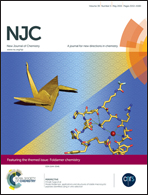Photoluminescence and white-light emission in two series of heteronuclear Pb(ii)–Ln(iii) complexes†
Abstract
Two series of Pb(II)–Ln(III) heteronuclear coordination complexes are assembled from a tripodal ligand triCB-NTB ((4,4′,4′′-(2,2′,2′′-nitrilotris(methylene)tris(1H-benzo[d]imidazole-2,1-diyl)tris(methylene))tribenzoic acid)). In the Pb2LnL2 series, the Ln3+ ion is encapsulated in a highly symmetrical {LnO6} octahedron with an inversion center, and Pb–Ln–Pb clusters are formed by the linkage of carboxyl groups on triCB-NTB ligands to Pb2+ and Ln3+ simultaneously. However, in the PbLn2L2 series, the Ln3+ ion is encapsulated in a distorted {LnO9} polyhedron without an inversion center. Pb2+ ions are coordinated with benzimidazole and apical N atoms on the ligand in isolation, and the carboxyl groups link two Ln3+ ions into a Ln–Ln cluster. This structural variation leads to different photoluminescence behaviour in these two series of complexes. Most importantly, the linkage of the Pb–Ln–Pb clusters causes more perturbation to the excited states of the ligand. Therefore, a more obvious ligand-to-metal charge transfer (LMCT) process is observed in the Pb2LnL2 series, and the energy transfer to the accepting levels of Ln3+ ions becomes more efficient. Furthermore, the combination of LC (ligand-centered) + LMCT + MC (metal-centered) emissions in the Pb2EuL2 complex results in single component white light emission.


 Please wait while we load your content...
Please wait while we load your content...